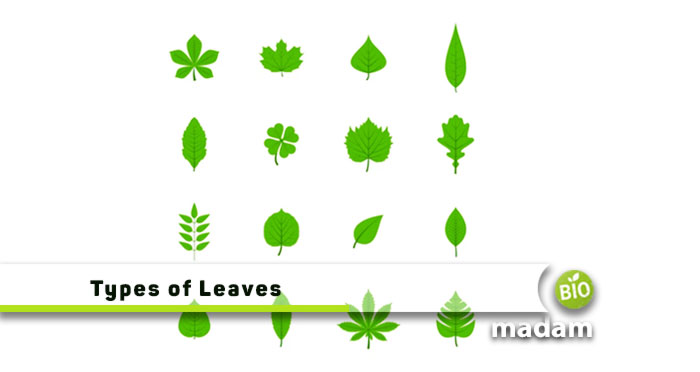Despite the attractive flowers and fruits, the leaves are the most prominent part of a plant. The top part of most plants including angiosperms and gymnosperms are covered with leaves, while a few smaller ones might have less. You can find various types of leaves, ranging from big palm tree leaves to cordate and elliptical leaves.
While there are so many trees around us, surprisingly, each has leaves different from the others. Horticulture and botany studies have found out various shapes, sizes and colors of leaves.
Understanding different leaves can help you identify and study their properties easily. Let us tell you about all types of leaves according to their classification on multiple bases.
We will study the types of leaves based on various kinds of classification, including
- Classification based on the structure
- Classification based on the arrangement
- Classification based on the shape
- Classification based on margins
- Classification based on plant
Get ready to learn everything about leaves today!
What is a Leaf?
Biology dictionary defines a leaf as “the organ that forms the main lateral appendage on the stem of vascular plants.” In general, leaves are thin, flat organs responsible for the photosynthesis of the plant.
In simple words, biological studies explain leaves as the extensions on the branches or stem of the plant. Plants are autotrophs instead of heterotrophs like other organisms. They are the producers in the food web and food chain. Thus, they use the upper surface of their leaves to photosynthesize, compared to chemosynthesis in some organisms.
Characteristics of Leaves
Considering so many types of leaves in plants, algae and fungi with varying characteristics, how to identify them? Whether the leaves are small, as in citrus trees, or huge, like the empress tree, they have a few features in common.
Here are a few characteristics you can find in all types of leaves in plants:
- They are a lateral appendage (extension) of the stem.
- They grow from the node of the branch.
- You can identify by the presence of veins (except liverworts)
- Leaves usually have an axillary bud but no apical bud.
- All leaves have a base, petiole, and lamina.
- The growth of leaves of each plant is limited.
Types of Leaves
While plants are typically categorized into vascular and non-vascular plants, the leaves are divided on the basis of their structure, arrangement and shape.
There are two basic types of leaves: simple and compound leaves. The compound leaves are further categorized into pinnately and palmately compound leaves with further sub-division within each division.
Biologists also classify leaves according to their shape for quick distinction. Keep reading to learn about all the types of leaves.
Classification of Leaves Based on Structure
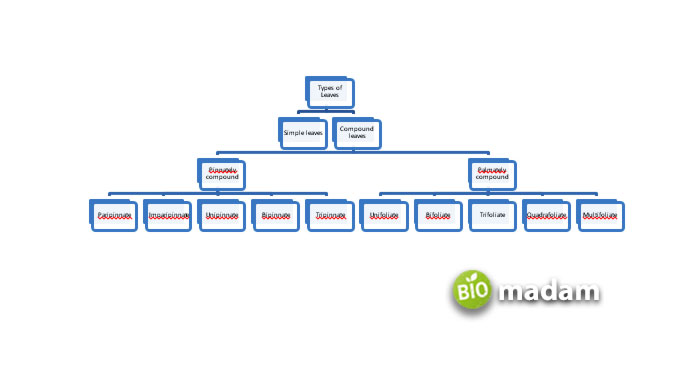
Simple Leaf
Simple leaves are defined as appendages of the stem with an undivided leaf blade. They may have multiple lobes but a single prominent vein. Only one leaf (or leaflet) is attached to the stem through the petiole.
Examples of simple leaves include mango, oak, and cherry leaves.
Compound leaves
Compared to simple leaves, compound leaves have prominent parts that separate them from the vein. Instead of one leaf, multiple small leaflets join on a single stem. Compound stems could be pinnately or palmately compound leaves.
Compound leaves examples are clover, neem, poison ivy, and mimosa.
Simple and acicular (needle-like) leaves do not have further specific categorizations. You may distinguish simple (or compound) leaves per the margin shape. However, compound leaves have a further network of division that we will discuss next.
Classification of Compound Leaves
Compound leaves are majorly classified as pinnately compound leaves or palmately compound leaves depending on their arrangement.
Pinnately Compound Leaves
A pinnately compound leaf has its leaflets arranged symmetrically on either side of the leaf’s central stalk. The leaflets look like they are attached to the midrib. Pinnately compound leaves can be paripinnate, imparipinnate, unipinnate, bipinnate, or tripinnate. They look like feathers and are native to North America.
Walnut, hickory, and pecan are some of the most commonly found pinnate leaves.
Types of Pinnately Compound Leaves
Pinnately compound leaves are organized according to their placement along the axis and the number of leaflets on the midrib.
Paripinnate
Paripinnate leaves are also known as even-pinnate leaves with leaflets in pairs on either side along the stem. Mimosa is a paripinnate plant.
Imparipinnate
Imparipinnate leaves are oddly-pinnated with a single leaf on the anterior terminal of the stem followed by leaves on each side. Ash and walnut have imparipinnate leaves.
Unipinnate
Unipinnate leaves have one compound leaf attached to the midrib on either side.
Bipinnate
Bipinnate leaves have unipinnate leaves on the stem instead of single leaflets.
Tripinnate
As the name suggests, tripinnate leaves have single leaflets replaced with bipinnate leaves.
Examples of unipinnate, bipinnate, and tripinnate compound leaves are neem tree, acacia, and moringa respectively.
Palmately Compound Leaves
Palmately compound leaves get their name from their shape, which looks like a hand. The leaflets of these leaves emerge from one common point giving it the shape of fingers around the palm. Maple and Poison Ivy are widely found palmately compound leaves.
Types of Palmately Compound Leaves
Unifoliate
Unifoliate refers to having only one leaf emerging from the axis point. Leman leaves are an example of unifoliate leaves.
Bifoliate
Bifoliate leaves have two leaves or leaflets emerging from a common point, such as the Chinese orchid plant.
Trifoliate
Some palmately compound leaves are trifoliate, with three gorgeous leaflets coming from the center point. Ivy-leaved maple has trifoliate leaves.
Quadrifoliate
As the name suggests, quadrifoliate has four leaflets with a common origin. The Oxalis plant has a quadrifoliate leaf type.
Multifoliate
Multifoliate leaves have five or more leaflets on tip of the petiole in the shape of palm fingers. Oleander and Aegle have multifoliate leaves.
Typically leaves are classified into simple and compound leaves. But, some classifications also show a third type; needle-shaped leaves.
Needle-Shaped Leaves
Needle-shaped leaves are common in many plants that surround our community and ecosystem. They are pointed and scaled with a waxy layer on the top surface. Like other leaves, they also vary considerably in size. You can find needle-shaped leaves of 1 inch up to 10 inches or more. They are typically found in colder regions.
Examples of needle-shaped leaves include pine and cedars.
Classification of Leaves Based on Arrangement
Leaves are divided into three types based on their attachment to the stem. These types represent the plant’s appearance depending on how the leaves attach to the node.
Alternate or Spiral Arrangement
If you have seen leaves that look like a ladder with steps on alternate sides, they are alternate leaves. You will see one leaf on any side of the stem with another leaf on the other side on the upper side. Plants with alternate leaf arrangements have one leaf per node.
Opposite Arrangement
In the opposite leaf arrangement, you can see leaves on either side of the stem. In such an arrangement, two leaves connect at a node.
Whorled Arrangement
Plants with a whorled arrangement of leaves have three or more leaves emerging from one node. They give a whorled look to the plant.
Classification of Leaves based on Shape
Besides the primary classification on the basis of leaf arrangement, there are various distinct types of leaves on different plants. Each of the type of plant, whether monocot or dicot, has a specific shape of leaves. They give a particular look and vibe to any plant. The common types of leave shapes include:
Elliptical Leaf
The elliptical leaf gets its name from its shape, which resembles an ellipse. The leaves are twice as long as wide and do not have parallel sides. Most have a slightly pointed top, while a few may have rounded tops.
While being among the most widely spread leaves, they are easily confused with other shapes and forms. They look incredibly similar to oblong leaves, which makes it difficult to differentiate. However, the widest part of elliptical leaves is near the middle.
Almond and Andaman Crape Myrtle are plants with elliptical leaves.
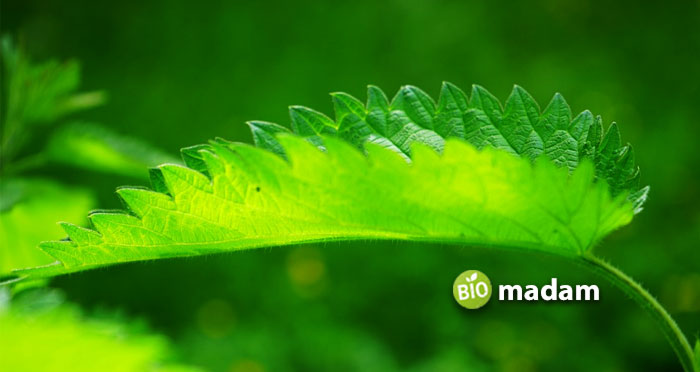
Linear Leaf
Linear leaves are the most basic simple leaves without any divisions. They have a narrow shape in which they are around four times longer than their width. While you typically see longer, flat linear leaves, some plants have cross-sectional, triangular, or square as well.
Some linear leaves have a twist along their length. Either side of the leaf is close to the midrib joining at a point.
Examples of Linear Leaves include grass and pearly everlasting.
Ovate Leaf
Ovate leaves are oval-shaped with sharp or rounded pointed tips. They are the most common type of leaves found on trees, bushes, and shrubs. These trees are broader at the base and taper towards the apex. Some ovate leaves have smooth edges, while others are serrated. They are typically 1.5 to 2 times longer than the width.
Elm trees and clearweed are common examples of ovate leaves.
Oblong Leaf
This kind of leaf is simply defined as simple leaves rounded at both ends, giving them the name oblong. As we mentioned earlier, oblong and elliptical leaves are somehow similar in shape. However, a major difference is that oblong leaves have parallel sides. Moreover, the sides are quite longer than the ends.
Citrus trees typically have oblong leaves.
Lanceolate Leaf
Lanceolate leaves generally look longer than other types of leaves, including oblong, elliptical, and linear. They get their name from their lance-like (long) appearance. They are 3 times longer than their width.
These leaves are flat and wider at the base compared to the midpoint. The leaf starts at the pedicel and broadens until it tapers at the apex.
Lanceolate leaves are a common sight in American Beech and Willow Oak.
Orbicular Leaf
Orbicular leaves have quite a distinct shape that makes it easy to identify them. They are almost circular without any divisions and shaped almost like an orb. Thus, the length and width of the lamina are almost equal.
You can easily spot orbicular leaves on the Purple Common Tree and lilacs because of their unique serrated shape.
Cordate Leaf
The term “cordate” translates to “heart-shaped.” Thus, cordate-shaped leaves are those with a pretty heart shape. Cordate leaves have deep indents on the joining point of the leaf and midrib, which gives it the shape of the top of the heart.
The leaf attaches to the petiole at the notched end, while the “cordate” shape refers to the leaf base more than the leaf shape. Eastern Redbud and Katsuratree have cordate or heart-shaped leaves.
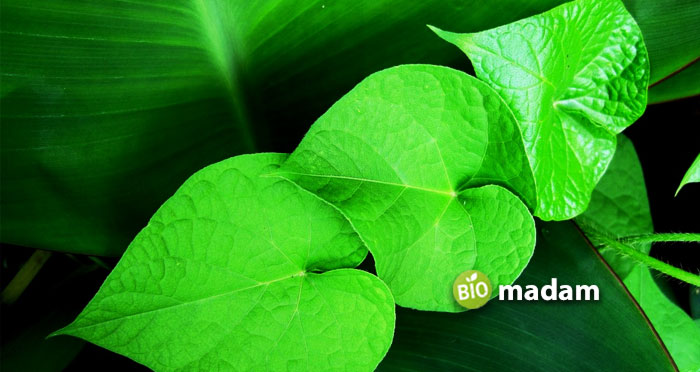
Cuneate Leaf
Like the cordate leaves, the classification and identification of the Cuneate leaves also rely more on the base of the leaf than the overall shape. However, they are different in look, with a wedge shape at the bottom. Their narrowly triangular shape tapers to the base at the point of attachment. Cuneati have a truncate at the apex and are more narrow than acute.
Cuneate leaves are a characteristic of Gray Dogwood and Star Magnolia.
Acicular Leaf
The acicular leaf is another name for needle-like leaves that do not fit the standard definition of leaves. These are common in leaves of colder regions to avoid snow accumulation and keep the plant lightweight.
Coniferous forests usually have acicular leaves on trees like the firs and pine trees.
Reniform Leaf
The word ‘Reniform’ arises from ‘Reni’ relating to kidney and ‘form’ exhibiting shape. Thus, it means leaves that have a kidney-like shape. You may also informally call it a bean-shaped leaf. They have a circular shape with a notch in which the notch is attached to the petiole.
Geranium has reniform leaves with flowers.
Sagittate Leaf
Sagittate leaves have a sharp triangular pattern with two pointed lobes reaching downward from the base. Their triangular pattern gives them the look of an arrowhead. Sagittate leaves are more common in aquatic plants and a few exotic trees you may not commonly find around.
Gregg arrowhead is a common example of a plant with Sagittate leaves.
Lyrate Leaf
Lyrate leaves are one of the most eye-pleasing leaves and are present on various outdoor and indoor plants. They get their name from the musical instrument ‘Lyre’ that the leaves look like. It has a curved U shape with a broad base wider at the top. They are divided into various lobes, of which the terminal lobe is the largest.
Harp-leaf Rockcress and Ficus are familiar examples of lyrate leaves.
Spatulate
Spatulate leaves are quite easy to point to as they have a shape similar to a spatula. The tip is not too wide, whereas the end is wider. Biologists believe that they also resemble Lanceolate leaves, except for the tip. While you can easily locate them because of the characteristic spatula-like shape, do not confuse Spatulate leaves with Lanceolates.
Fire Pink plant with gorgeous flowers has spatulate leaves.
Types of Leaves According to Margins
Understanding the kinds of plant margins can also help identify and pick them out easily, among other types. Here are the five fundamental margin types you will find on any leaf.
Entire
Entire leaf margins refer to a plant leaf without any serration or lobes. They are smooth on all edges. They are also called smooth margins.
Wavy
Wavy margins, also known as undulate margins, do not have serrations. While smooth, they have a wavy pattern throughout the leaf.
Crenulate
Crenulate leaves have toothed margins which are more rounded toothed than pointy.
Toothed
Toothed margins, more commonly known as serrated margins, are cut into small segments like crenulate margins. However, serrated margins are sharply pointed.
Lobed
Instead of small toothed edges, lobed leaves have large blunt segments. Depending on the species, you may see leaves with a few or many lobes.
Types of Leaves According to Plants
Now that we have discussed all the major types of leaves according to their structure and shape, why not tell you about the characteristic leaves as per the plant type?
While a few kinds of leaves are present on various trees and plants, some are specific to one specie or family. Here’s a short description of the different types of leaves according to plants.
Angiosperm Leaves
As the name indicates, angiosperm leaves refer to the foliage of flowering plants like the rose.
Sheath Leaves
Sheath leaves are not typically present on trees or large plants. They are elongated generally in lanceolate shape. Grasses have tubular sheath leaves.
Conifer Leaves
Conifers leaves are needle-like and pointed and found in pine and firs.
Fronds
The leaves of plants like club mosses are known as fronds.
Specialized Leaves
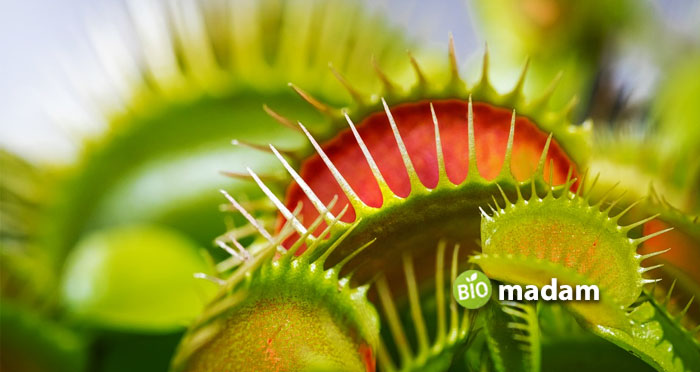
Leaves of exotic plant species and insect-eating plants do not look like the common plant types. Venus flytraps’ unusual leaves are an example of specialized leaves.
The Bottom Line
Leaves are critical for plants as they participate in photosynthesis and help produce food. With so many assortments of trees, shrubs, plants and algae, the types of leaves are also numerous. You can find lanceolate, cordate, elliptical, oblong, spatulate, and many more types of leaves around us. Some leaves, like the acicular leaves, differ from the typical foliage. Besides different shapes, they also vary in structure. For example, simple leaves do not have leaflets like compound leaves. You may find unipinnate, bipinnate, etc., compound leaves as well.
The unique kind of foliage on each plant does not give it a unique identity or enhance the aesthetic value of the plant; they also differ in function. Such as, the leaves of conifers are needle-like as they grow in cold regions. These leaves allow them to stay lightweight without accumulating much snow.
FAQs
What are three types of leaves?
The three common types of leaves are simple, compound, and acicular. Simple leaves consist of a single leaf, compound leaves have multiple leaflets, and acicular leaves are shaped like needles. Furthermore, all foliage might be categorized as alternate, opposite, or whorled leaves, depending on their arrangement.
Why are there different types of leaves?
While many trees might have had the same kinds of leaves since the existence of the universe, the leaf variations show evolutionary and ecological evolution over time. Different kinds of plants might have evolved due to environmental restrictions.
What are the most common leaves?
As the most widely found plants around us are deciduous trees and shrubs, angiosperm leaves are the most common. You can locate linear, ovate, and lanceolate leaves quite easily. They are typically arranged spirally or oppositely and maybe simple, palmately compound or bipinnate, or tripinnate.

Hello, I would like to introduce myself to you! I am Chelsea Rogers, an experienced blog writer for science articles, holding an MPhil degree. My enthusiasm to grab the best knowledge, let it relate to botany, zoology, or any other science branch. Read my articles & let me wait for your words s in the comment section.

